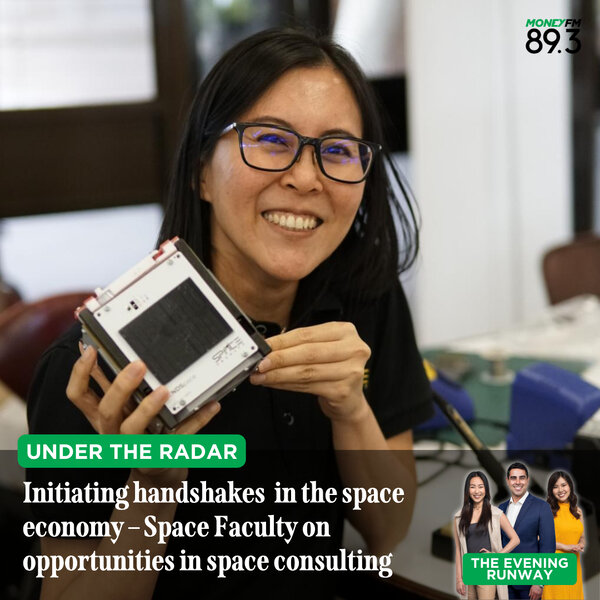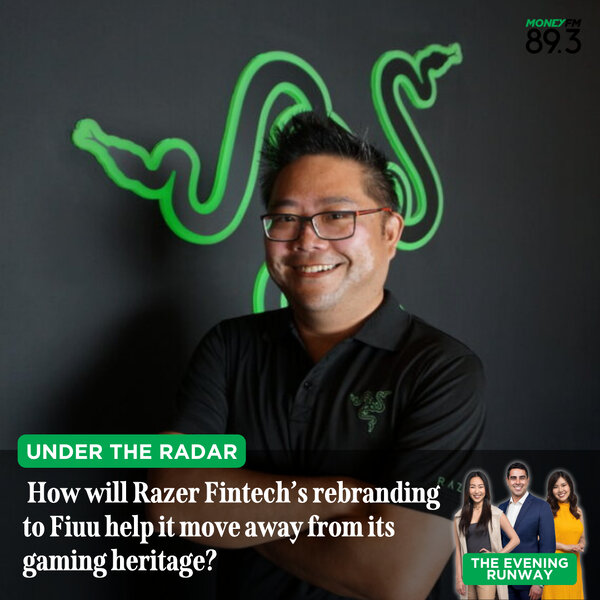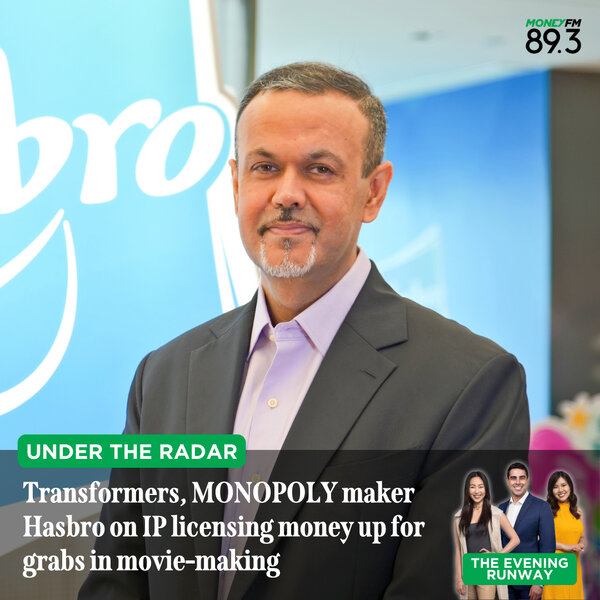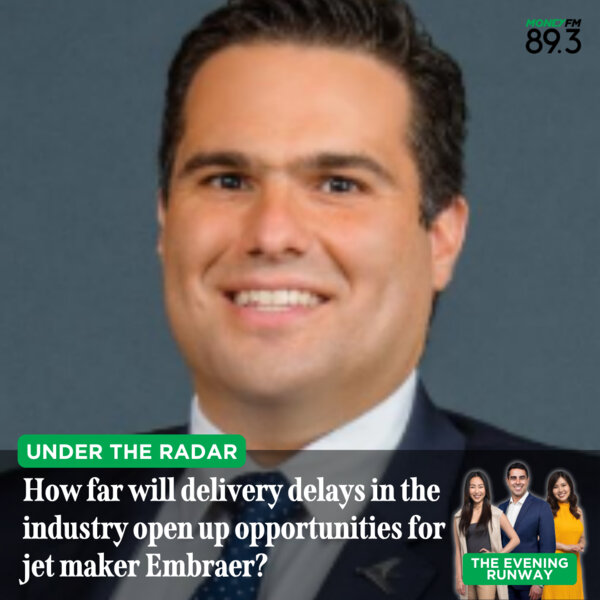
Under The Radar
About
We speak with businesses, industry leaders, venture capitalists and startups on their assessment of the business environment they're in, and what the future holds for them.
MAY 31, 2024
31/05/24 - Under the Radar: Initiating handshakes between private and public organisations in the space economy – Space Faculty on opportunities in the space consulting industry
Founded in 2021, our guest Space Faculty is a business consulting firm and also a pioneer in helping the public and private sectors be a part of the space economy.
The firm’s operations can be segmented into three verticals: one, helping the private sector tap into space-based and deep tech innovations, two, developing national-level STEM 2.0 learning roadmaps for youths and professionals, and three, working with governments to create, expand, and leverage the space industry ecosystem.
For example, the company worked with the Singapore Land Authority to come up with a technology challenge to mobilise youths to develop solutions and prototypes that help SLA’s technologies impact different parts of the community.
It also supports the Office for Space Technology and Industry, Singapore by building a pathway for talent development through bespoke programmes and industry connection points to complement the education system and meet growing industry demand.
Globally, the firm also has a long-term partnership with the US Embassy for the International Space Challenge to showcase the breadth of established and emerging space companies in the global ecosystem, and help them maintain their mindshare in the space industry.
But why are we talking about Space Faculty? Well, McKinsey & Company had in an April report estimated that the global space economy will be worth US$1.8 trillion by 2035, taking into account inflation. That’s a multiple of the US$630 billion seen in 2023.
But where are the untapped opportunities in this space (pun intended) – and how far does that translate into earnings for Space Faculty?
On Under the Radar, The Evening Runway’s finance presenter Chua Tian Tian posed these questions to Lynette Tan, CEO, Space Faculty.
|
|
|
|
34:43
|
MAY 29, 2024
29/05/24 - Under the Radar: How will Razer Fintech’s rebranding to Fiuu help it move away from its gaming heritage and be a leading force in the future of digital payments? – Its Executive Chairman Limeng Lee sheds light on the matter
Today we’re going to bring you an inside look into the B2B merchant services and fintech arm of Razer, Fiuu.
Established back in April 2018 as Razer Fintech, Fiuu has grown to become the one of the largest O2O or Offline to Online digital payment networks in emerging markets and has processed over billions of dollars in total payment value.
For one thing, Fiuu recorded a Total Payment Volume, or TPV of over US$6.6 billion for FY 2023, positioning it as one of the largest payment processors in Southeast Asia.
Its business encompasses two verticals namely payment services and reload services. In terms of payment services, the firm supports global scheme cards and over 110 payment methods to power online and offline payments for global and regional blue-chip merchants in Southeast Asia.
On the reload services front, the firm has built the region’s largest offline payment network with over 1 million physical acceptance points. This includes cash-over-counter services like the fulfilment of e-commerce purchases, bill payments and telco reloads and merchant acquiring services for third party e-wallets.
Why are we talking to Fiuu you might ask? Well, the firm was rebranded from Razer Fintech to Fiuu in March this year to reinforce its intentions to become a leading force in the future of digital payments.
But how far does the rebranding initiative allow the firm to move away from its gaming heritage?
Meanwhile, a report by Google, Temasek and Bain & Company noted that digital payments now make up over 50% of transactions in Southeast East Asia. But what opportunities does this provide to Fiuu and Razer?
On Under the Radar, The Evening Runway’s finance presenter Chua Tian Tian posed these questions to Limeng Lee, Executive Chairman, Fiuu, and Chief Strategy Officer, Razer.
|
|
|
|
30:06
|
MAY 27, 2024
27/05/24 - Under the Radar: Transformers, MONOPOLY, Play-Doh maker Hasbro on IP licensing, power brands that drive growth, money up for grabs in the movies and entertainment space
Optimus Prime is in the house today as we speak to the company behind the Transformers franchise.
Founded in 1923, our guest Hasbro actually started out selling textile remnants and pencil boxes before becoming the leading toy and game company it is today.
Now, the firm aspires to entertain and connect generations of fans through the exhilaration of play.
Some of the names under the company’s portfolio include Play-Doh, Monopoly, Peppa Pig, Transformers, Dungeons & Dragons, Hasbro Games as well as other premier partner brands.
The firm had in April reported a smaller-than-expected drop in Q1 sales as leaner inventories and a steady stream of digital gaming revenue bolstered it from softer demand for toys.
But with Grand View Research valuing the global toys and games market at US$324.7 billion in 2023 and the industry set to grow at a CAGR of 4.3% from 2024 to the end of the decade (2030), how does Hasbro assess its road ahead? Which brands will continue to drive growth?
Speaking of brands, the firm appears to be doubling down on its Monopoly brand, especially after the Monopoly Go mobile game reached US$2 billion in revenue in the first 10 months since its launch.
For one thing, it had in April this year signed a deal with LuckyChap, the award winning production company headed by Margot Robbie to produce a motion picture movie based on the Monopoly classic board game.
A Transformers animated movie is also set to release in September. But how far will movie production help Hasbro drive mind-share and profits looking at the success of its competitor Mattel and the Barbie movie?
On Under the Radar, The Evening Runway’s finance presenter Chua Tian Tian posed these questions to Bhavesh Somaya, Senior Vice President, Asia Pacific, Hasbro.
|
|
|
|
36:57
|
MAY 23, 2024
23/05/24 - Under the Radar: Moroccan-based phosphate fertiliser maker OCP Group on how climate change influences demand, opportunities in Southeast Asia and more
Phosphate provides a quarter of all nutrients plants need to grow and thrive. It is an essential ingredient in all fertilisers that go to support the crops we eat and use in our daily lives.
And it is all about phosphate today as we speak to one of the world’s largest custodians and suppliers of phosphate-based fertilisers.
Founded over a century ago in Morocco, our guest OCP Group started out as a single mine producing phosphate at Khouribga. Production started in March 1921, with exports done via the port at Casablanca done later that year.
The company diversified over the years, moving to phosphate processing at Safi in 1965 and in Jorf Lasfar in 1984. It also became a state owned company under the Moroccan Government in 2008 and the Banque Populaire du Maroc.
Fast forward to today, the firm’s operations now span across five continents and throughout the value chain ranging from mining, processing, manufacturing, exporting to even education and community development. Just to give you a sense of its scale, OCP now has sole access over 70% of the world’s phosphate reserves.
Some of its products include raw materials like rock phosphate, phosphoric acid, standard and fortified fertilisers, as well as animal feed.
Per the Moroccan World News, the firm reported revenues of 91.27 billion Moroccan Dirhams (or MAD or US$9 billion) in 2023, despite a drop in fertiliser prices. That is lower than the US$11.3 billion in the year prior. But which are the firm’s major demand markets contributing to the numbers and what is the role of Singapore in this regard?
And with poor weather conditions affecting the yield of crops like cocoa and Robusta coffee beans – what implications will this have on fertiliser makers?
Meanwhile, the firm had in April raised US$2 billion in a dual tranche Eurobond to fund its green transition plan, but what can we expect here in Southeast Asia?
On Under the Radar, The Evening Runway’s finance presenter Chua Tian Tian posed these questions to Bhavya Sehgal, General Manager, Singapore, OCP Group.
|
|
|
|
31:52
|
MAY 20, 2024
20/05/24 - Under the Radar: Carpool app Ryde’s Founder and Chairman Terence Zou on the firm’s NYSE IPO and concerns over profitability
It’s all about your day-to-day commute today as we speak to the first carpool app developed in Singapore.
Founded in September 2014, Ryde leverages technology to facilitate the movement of people and goods by providing on-demand and scheduled carpooling and ride-hailing services.
While the firm has its origins as a carpool app, it has since expanded to provide a full suite of mobility and delivery options , and even established extended product services such as e-payments, taxi bookings and insurance purchases.
Ryde’s services are currently available in Singapore, though the firm has a footprint in other regional markets such as Malaysia, Hong Kong and Australia.
But why are we talking about Ryde you might ask? Well the firm made history in March this year by becoming the first Singaporean ride-hailing startup to debut on the New York Stock Exchange.
The firm has said then that it plans to use the proceeds to expand globally and improve its technology infrastructure.
But what is of concern here is that the listing comes at a time when Ryde registered a net loss of S$4.96 million on S$8.8 million of revenues in 2022, per its IPO prospectus. Loss for the six months ended June 2023 also came in at close to S$4 million.
So is this the right time for Ryde to double down on capital expenditures and capture market share? Is a flush in investors’ and in particular institutional investors’ money the key to help the firm lay the groundwork towards profitability?
On Under the Radar, The Evening Runway’s finance presenter Chua Tian Tian posed these questions to Terence Zou, Founder, Chairman and Chief Executive Officer of Ryde Group Ltd.
|
|
|
|
31:43
|
MAY 16, 2024
16/05/24 - Under the Radar: Behind the clothes sold in Macy’s, Walmart – Singapore’s Ghim Li on the importance of vertical integration, growth trends in clothing OEM and ODM, impact of the green push on top and bottom lines
Today we’re going to talk about a company behind the clothes you buy while on holiday in the US.
This is because that piece of garment you’ve bought from retail giants Walmart and Macy’s could very well be traced back to Singaporean textile and clothing maker Ghim Li!
Founded all the way back in 1977 with a collection of six sewing machines and a capital injection of US$3,000, Ghim Li has evolved to become an Asia-wide textile and apparel maker of casual lifestyle knitwear.
The company prides itself as a one-stop shop that integrates various parts of the apparel manufacturing supply chain, providing services from product design, development and commercialisation, material management, production planning and control, to post manufacturing logistics.
Today, the Singapore-headquartered and Australia-listed firm has international sales offices and contracted manufacturing partners in Cambodia, Indonesia, Malaysia, and a workforce of over 8,000.
Its supplies over 62 million pieces of garments a year to some of the biggest Fortune 500 companies such as Macys Aeropostale, Foot Locker, and Walmart, and also provides ODM (Original Design and Manufacture) as well as OEM solutions to customers.
But what has been the company’s secret recipe for success thus far and how far can that be attributed to the firm’s control over its supply chains?
What will be the key drivers of growth looking ahead? Also – how far would the ongoing push for sustainability in the fashion industry influence the way Ghim Li approaches its business?
On Under the Radar, The Evening Runway’s finance presenter Chua Tian Tian posed these questions to Felicia Gan, CEO, Ghim Li Group of Companies.
|
|
|
|
24:30
|
MAY 14, 2024
14/05/24 - Under the Radar: How rewarding is it for Unilever International to build inroads to serve remote and secondary markets?
Ice-cream, sauces, seasoning powders, dish soaps, shampoos, deodorants, laundry detergent and hand sanitisers.
There is one common factor linking all these products together – and that’s they are all fast moving consumer goods or FMCGs. In fact our guest for today is part of one of the world’s leading FMCG firms Unilever.
That is the company behind brands such as Lipton, Knorr, Dove, Hellmann’s as well as your Wall’s Ice-Cream, Lifebuoy hand soap and Comfort fabric softener.
More specifically, we are speaking to Unilever International. Founded in 2012, Unilever International is the white space partner for Unilever, and was set up to serve emerging and fast growing geographies, consumers, customers and channels created worldwide as a result of mega trends such as globalisation, migration and digital commerce.
Fast forward to today, Unilever International operates out of eight key hubs in major cities such as London, Rotterdam, Singapore, Dubai, Mumbai and Seoul.
It also provided over 100 million consumers in remote markets like Yemen, Mongolia and East Timor access to Unilever products, such as Wall’s ice cream and Vaseline lip balm. But how rewarding is it for the firm to build supply chains outside of major cities where the dollars and cents are concerned?
Meanwhile, Unilever International had last year expanded its network of partnerships to the travel sector, serving over 50 Fortune 500 companies like IHG Hotels, Marriott, Delta Airlines, Singapore Airlines with items such as Dove amenities in room or in-flight, reaching over 200 million consumers per annum. But how far will that translate into earnings for Unilever as a whole?
On Under the Radar, The Evening Runway’s finance presenter Chua Tian Tian posed these questions to Aseem Puri, Global CEO of Unilever International.
|
|
|
|
28:37
|
MAY 10, 2024
10/05/24 - Under the Radar: How far will safety incidents at Boeing, jet delivery delays in the industry open up opportunities for world’s third largest aircraft manufacturer Embraer?
It’s all about flying high today as we speak to the world’s third largest commercial aircraft maker after Airbus and Boeing. Make a guess - we’re actually talking about Brazilian aircraft manufacturer Embraer!
Founded in 1969, Embraer is a global aerospace company that designs, develops, manufactures and markets aircrafts and systems with businesses spanning across areas such as Commercial and Executive Aviation, Defense & Security, and Agricultural Aviation.
More notably, the firm started out making a turboprop plane called the Bandeirante, which was designed for both civilian and military purposes.
50 over years down the road, the company delivered over 8,000 aircrafts. That translates to having one of its aircrafts taking off somewhere in the world every 10 seconds, we’re talking about mostly jets up to 150 seats serving regional routes.
Why are we talking to Embraer you might ask? Well, the firm had reported sizable growth in all business units for the last quarter of 2023 with commercial aviation revenues rising 20 per cent.
The number of Executive Aviation jet deliveries, according to media reports, were also at the highest in seven years. But how far is that driven by the post-pandemic travel recovery? Where are the bright spots for the firm?
And with Boeing in the spotlight amid a slew of safety incidents surrounding its 737 Max models and Airbus delays, what will this mean for Embraer? Would it move to build larger planes to rival the two jet makers as what media reports had suggested in recent days?
Closer to home, Embraer had in April delivered the first of nine new Embraer E190-E2 aircraft to Scoot to allow the airline to expand its network growth strategy and expand into markets with smaller, but sizeable demand. But what can we look forward to from here?
On Under the Radar, The Evening Runway’s finance presenter Chua Tian Tian posed these questions to Raul Villaron, Vice President, Asia Pacific, Embraer Commercial Aviation.
|
|
|
|
35:58
|
MAY 8, 2024
08/05/24 - Under the Radar: Gojek Singapore’s GM on driver supply crunch, path to profitability and whether players in the ride hailing industry can achieve sufficient economies of scale
This is a company that you’ll come into contact with perhaps on a day to day basis.
Make a guess - if you’re thinking along the lines of ride hailing apps - you’re on the right track! Established back in 2010, our guest is Southeast Asia’s ride hailing giant and leading on-demand platform Gojek.
Fun fact here, the firm actually started out as a call centre focusing on courier and motorcycle ride-hailing services in the early 2010s before launching its app in January 2015 in Indonesia.
Fast forward to today, the firm provides access to a wide range of services including transportation, food delivery and logistics, with the aim to use technology to remove life’s daily frictions.
It now operates in markets including Indonesia, Vietnam and Singapore with over 2.5 million driver partners across the region.
Gojek’s parent company GoTo Group reported that it turned EBITDA positive in the fourth quarter of the financial year ended 2023, even as the full year’s net loss widened by over 120%. But how far did Gojek Singapore contribute to the group’s performance?
Also – how does Gojek Singapore assess its path to profitability in looking ahead with Q1 2024’s figures just in?
Meanwhile, the firm recently announced a partnership with taxi operator ComfortDelGro that it will dispatch rides not taken up by drivers to each other’s platform.
But how far will the collaboration bolster Gojek’s financials and help it increase customer retention with the shortage of drivers being a perennial issue within the industry here in Singapore?
On Under the Radar, The Evening Runway’s finance presenter Chua Tian Tian posed these questions to Lien Choong Luen, General Manager, Gojek Singapore.
|
|
|
|
33:33
|
MAY 6, 2024
06/05/24 - Under the Radar: SGX-listed HRnetGroup’s Chief Corporate Officer sheds light on the recruitment and staffing landscape, lowering revenues and improving margins
The recruitment and staffing landscape is in focus as we speak to one of the leading talent acquisition and management firms here in Asia.
Founded in 1992, HRnetGroup helps business leaders, hiring managers and job seekers build stronger companies, successful careers and better workplace cultures.
The firm’s business segments can be split into two, namely flexible staffing or the provision of temporary manpower solutions to companies, as well as professional recruitment, where it sources permanent staff for corporate staff.
The Singapore headquartered and SGX listed firm started off as a 4-man team and grew to a headcount of over 900 consultants across 17 Asian cities, such as Singapore, Kuala Lumpur, Hong Kong, Taipei, Beijing, Seoul and more.
Its business portfolio includes 14 brands such as HRnetOne, SearchAsia, and Yespay.
HRnetGroup had in February posted a 7.1 per cent year-on-year increase in net profit to S$35.3 million for the second half of 2023 driven by strong profit margins.
That’s even as revenue for the period fell 4.7 per cent on the year to S$283.7 million amid tough economic conditions and sector-wide profit downgrades.
It also noted that revenue trends were patchy. So how does the firm assess its road ahead, especially amid news of global firms streamlining their operations this year? Which brands continue to make meaningful contributions to the group?
Meanwhile, the firm had in 2022 acquired stakes in a number of businesses, such as a majority stake in local cloud-based workforce management software firm Octomate.
It also co-invested half a million Singapore dollars into the flexible staffing business of Recruit First Indonesia that year. But how far have the acquisitions reaped financial gains for the firm? And what’s next on the firm’s to buy list?
On Under the Radar, The Evening Runway’s finance presenter Chua Tian Tian posed these questions to Adeline Sim, Chief Corporate Officer, HRnetGroup Limited.
|
|
|
|
19:05
|







